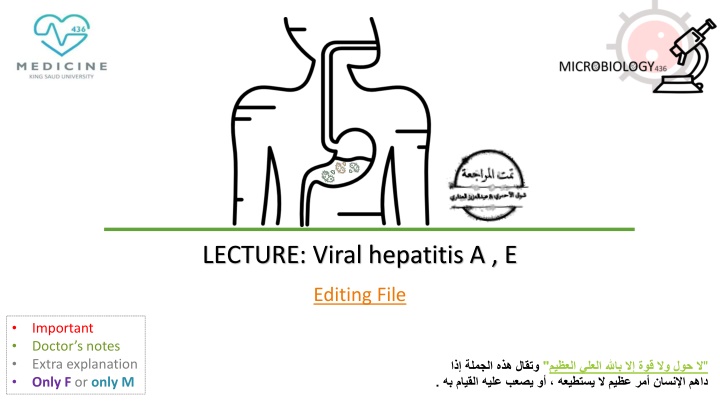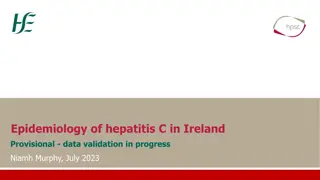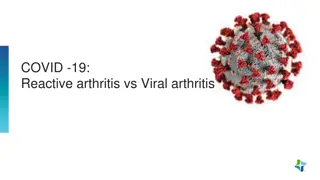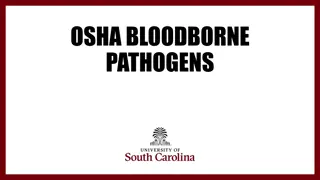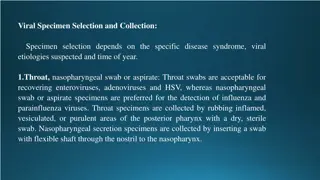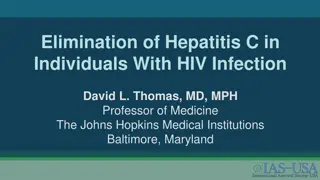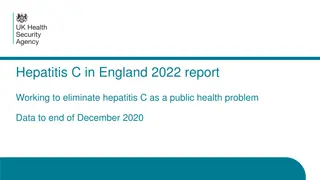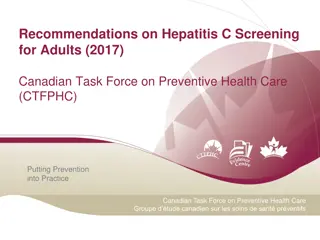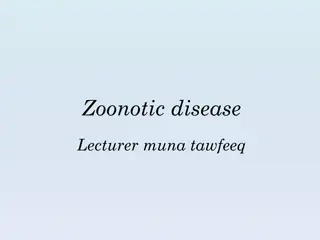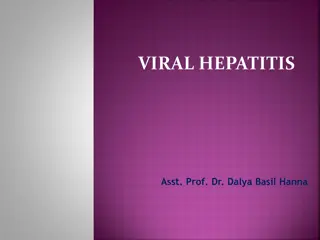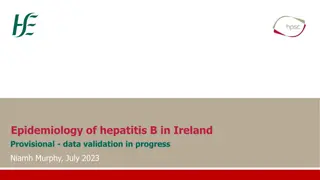LECTURE: Viral hepatitis A , E
Viral hepatitis is inflammation of the liver caused by different viruses. This lecture focuses on understanding the classification, transmission, symptoms, and management of Hepatitis A and E viruses, including important information on prevention and treatment options.
Download Presentation

Please find below an Image/Link to download the presentation.
The content on the website is provided AS IS for your information and personal use only. It may not be sold, licensed, or shared on other websites without obtaining consent from the author.If you encounter any issues during the download, it is possible that the publisher has removed the file from their server.
You are allowed to download the files provided on this website for personal or commercial use, subject to the condition that they are used lawfully. All files are the property of their respective owners.
The content on the website is provided AS IS for your information and personal use only. It may not be sold, licensed, or shared on other websites without obtaining consent from the author.
E N D
Presentation Transcript
LECTURE: Viral hepatitis A , E Editing File Important Doctor s notes Extra explanation Only F or only M " " .
OBJECTIVES: Know the classification of viruses causing hepatitis. Viruses causing entericaly transmitted hepatitis:HAV,HEV. Viruses that are causing hepatitis during their course of infection: Cytomegalovirus (CMV) ,Epstein-Barr virus (EBV),Arbovirus (yellow fever virus)
Hepatitis: Hepatitis: Hepatitis: is inflammation of the liver. Etiology: A) Primary infection: B) As part of generalized infection: - Hepatitis A virus (HAV) - Hepatitis B virus (HBV). - Hepatitis C virus (HCV), was known as non-A non-B hepatitis. - Hepatitis D virus (HDV) or delta virus. - Hepatitis E virus (HEV). - Hepatitis F virus (HFV) Hepatitis F has been reported in the literature but not confirmed. - Hepatitis G virus (HGV). (CMV, EBV, Yellow fever virus) Viral hepatitis is divided into two large groups, based on the mode of transmission: 1 Enterically transmitted hepatitis or water-borne hepatitis 2 Parenterally transmitted hepatitis or blood-borne hepatitis This group includes hepatitis A and E viruses This group includes hepatitis B, C, D & G viruses HAV and HEV belong to different families
Hepatitis A Virus Hepatitis A Virus o Family of Picornaviridae. o Genus: Hepatovirus. o Virion non-enveloped and consist of: 1. Icosahedral capsid. 2. Positive sense ss-RNA. Other names for hepatitis a virus: o Short incubation hepatitis (Hepatitis E virus is longer) o Infectious hepatitis o Epidemic hepatitis Characteristics: Epidemiology Worldwide, endemic in tropical countries Due to poor hygiene Fecal-oral route [major route] :Contaminated food &water Like eating infected shellfish harvested in the fecal contaminated order or uncooked food like salad In developing countries; children The most affected group of age due to poor hygiene Distribution: Transmission: Sexual contact (homosexual men) Blood transfusion (very rarely) Age: In developed countries; young adults Acute infection Hepatitis: Asymptomatic & anicteric infection is common Symptomatic illness increases with age Incubation period=2-6 Weeks Two Phases: 1- Pre-icteric phase: fever, fatigue ,nausea, vomiting, & RUQP (right upper quadrant pain) 2- Icteric phase: dark urine, pale stool, jaundice Manifestations Virus is found in stool during incubation period + prodrome period before symptoms start to appear, and when symptoms appear the concentration of virus decline in the stool Icteric means jaundice
Hepatitis A Virus Hepatitis A Virus Pathogenesis: The virus enters the body by ingestion of contaminated food. It replicates in the intestine (epithelium), and then spread to the liver where it multiplies in hepatocytes. Cell mediated immunity Damage of virus-infected hepatocytes increase ALT, AST & Bilirubin Managment Treatment: Supportive therapy Prevention: Sanitation & hygiene measures HIG (human immunoglobulin): Given before or within 2 Weeks of exposure (shorter immunity) -Indication: travellers, unvaccinated, exposed patients. Vaccine: inactivated (longer immunity), Given IM in two doses ->1 Y of age -Indication: Patients at high risk of infection and severe disease Lab Diagnosis Serology: Detection of anti-HAV IgM Current infection Detection of Anti-HAV IgG Previous infection OR Immunity Self-limited disease* Fulminant hepatitis rareSevere necrotic infection of Lever lead to liver failure Mortality rate ~ 0.1 - 0.3% No chronicity or malignancy changes Prognosis * Usually patient recovers within few weeks, however The majority of the infectionare asymptomatic
Hepatitis E virus Hepatitis E virus Characteristics: Family of Hepeviridae. Genus: Hepevirus. Virion non-enveloped and consist of: Icosahedral capsid. Positive sense ss-RNA. Epidemiology Distribution: Outbreak of water-borne & sporadic cases of viral hepatitis Transmission: 1. Water-borne The main route 2. Zoonotic (from animals) food borne. (from pork) Age; young adults 3. Blood-borne Rare 4. Perinatal From pregnant mother to her baby Age: Clinical features: Similar to HAV infection with exceptions: Longer incubation period =4-8 weeks Acute and Chronic hepatitis, cirrhosis, but not hepatocellular carcinoma (HCC) Fulminant disease Mortality rate ~10 times > HAV / ~ 1-3% / [20% in pregnancy] ELISA Anti-HE IgM Not specific In immunocompetent Sanitation & hygiene measures No Immunoglobulin No vaccine Lab diagnosis: Treatment: Prevention:
Herpesviridae Herpesviridae: : dsDNA , Icosahedral & Enveloped Virus HSV-1 1-Herpes simplex virus type-1 HSV-2 2-Herpes simplex virus type-2 VZV 3-Varicella Zoster virus EBV 4-Epstein-Barr virus They cause hepatitis CMV 5-Cytomegalovirus HHV-6 6-Human herpes virus type-6 HHV-7 7-Human herpes virus type-7 HHV-8 8-Human herpes virus type-8 Type 1-6 are mild self-limited in immunocompetent but severe in immunocompromised patients
Epstein Epstein Barr Virus (EBV): Barr Virus (EBV): *Infect lymphocytes mainly B lymphocyte Characteristics: It is lymphotropic*. It has oncogenic properties; (Burkitt s lymphoma, Nasopharyngeal carcinoma) Epidemiology Distribution: worldwide Transmission: 1-slaiva (kissing disease) socio-economic state(SE): 1-Low SE : early childhood (developing countries) 2-High SE : adolsence (developed countries) 2-blood(rare) Age: Clinical features: 1-immunocompetive host: Asymptomatic Usually Infectious mononucleosis [or glandular fever] Mainly in teenagers & young adults IP = 4-7 weeks Fever, pharyngitis, malaise, hepatosplenomegaly & abnormal LFT, hepatitis. Complications: (acute air way obstruction, splenic rupture, CNS inf) Rare 2-immunocompremised host: (HIV) Lymphoproliferative disease ( LD) Oral hairy leukoplakia (OHL) Lab diagnosis: Hematology: increased WBC Lymphocytosis (atypical lymphocytes) Serology: 1- Non-specific AB test : -Heterophile Abs +ve -Paul-Bunnell or -monospot test 2- EBV-specific AB test: IgM Abs to EBV capsid antigen Treatment: Prevention: Antiviral drug is not effective in IMN no vaccine
Cytomegalovirus (CMV) Cytomegalovirus (CMV) Special features: -Its replication cycle is longer. -Infected cell enlarged with multinucleated.[cyto=cell, megalo=big](change in cell ) -Resistant to acyclovir. -Latent in monocyte, lymphocyte & other Distribution: worldwide Transmission: Early in life: Transplacental From pregnant mother to her baby causing a congenital infection- Birth canal - Breast milk Young children: saliva Later in life: sexual contact, Blood transfusion & organ transplant. 1-Acquired Infection: a)Immunocompetent host: Asymptomatic - Self-limited illness Hepatitis - Infectious mononucleosis like syndrome [Heterophile AB is ve] b)Immunocompromised host : Encephalitis , Retinitis , Pneumonia - Hepatitis, Esophagitis, Colitis. 2- Congenital Infections The difference between infectious mononucleosis and infectious mononucleosislike syndrome is: - the first one is caused by Epstein herpesvirus + pharyngitis + positive heterophile - the second by cytomegalovirus + rare pharyngitis + negative heterophile
Cytomegalovirus (CMV) Cytomegalovirus (CMV) Histology: Intranuclear inclusion bodies [Owl s eye] Lab diagnosis: Culture: In human fibroblast 1-4 wks CPE (very slow growing disease) Shell Vial Assay 1-3 days Serology : 1-AB : IgM: current infection IgG: previous exposure 2-Ag: CMV pp65 Ag by IFA PCR Treatment: Ganciclovir : is effective in the treatment of severe CMV inf. Foscarnet: the 2nd drug of choice Prevention: Screening Leukocyte-depleted blood. Prophylaxis: Ganciclovir, CMVIG. No vaccine. Organ donors Organ recipient Blood donors
Arthropod Arthropod borne Viruses (Arboviruses) borne Viruses (Arboviruses) Yellow Fever virus (because of jaundice) Yellow Fever virus (because of jaundice) Family: Flaviviridae Asymptomatic to Jaundice + Fever hemorrhage renal failure Epidemiology Tropical Africa & South America: 1-Jungle Yellow Fever 2-Urban Yellow Fever Jungle Yellow Fever Jungle Yellow Fever Urban Yellow Fever Urban Yellow Fever Vector: mosquito Reservoir: human It is a disease of humans Vector: mosquito Reservoir: monkeys Accidental host: humans It is a disease of monkeys
Arthropod Arthropod borne Viruses (Arboviruses) borne Viruses (Arboviruses) Yellow Fever virus (because of jaundice) Yellow Fever virus (because of jaundice) Diagnosis -Reference Lab -Lab Methods: A- Isolation (Gold standard) B -IgM-Ab - ELISA, IF: (most used) C - Arbovirus RNA by RT-PCR Prevention 1-Vector Control: Elimination of vector breading sites Using insecticides Avoidance contact with vectors 2-Vaccines: Yellow Fever vaccine (LAV, one dose /10 yrs) is recommended for travelers
THANK YOU FOR CHECKING OUR WORK, BEST OF LUCK! Hamad Alkhudhairy Meshal aleidi Abdulmalik alghanam Shrooq Alsomali Rawan Alqahtani Ghaida Alsaeed Doctors slides
